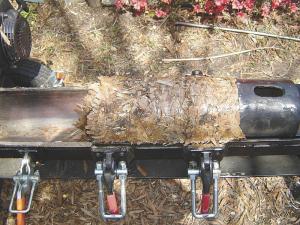Log Splitter Also Makes Logs Out Of Leaves
Rusty Ashby sells a unique log splitter that splits logs but then can also be used to make compressed logs from leaves, grass, aluminum cans or just about anything that can be compressed. Almost any kind of biomass, including pine straw, pine needles, shredded pinecones and leaves, can be turned into logs that will burn hot for up to 3 hrs. The double-duty splitter transforms from one use to the other in about 5 min.
“It’s a 22-ton splitter, and I’ve split sections of logs with a 24-in. diameter,” says Ashby. “I can turn around and make 6-in. diameter, 22-in. long logs out of leaves, pine needles or aluminum cans.”
Ashby’s splitter converts to a compressor with the addition of a hopper and compression chamber. The two-part steel chamber has a 6 1/4-in. outside diameter. The hydraulic ram has a 6-in. outside diameter, 12-in. long head that gathers leaves, cans or other material from the bottom of the hopper. Ashby uses a steel tamper to move materials through the 6 by 12-in. hopper mouth and into the chamber. He then activates the ram for the next compression.
“Yard waste and other biomass can be compacted into a log in about 8 min.,” says Ashby. “I can compress 200 aluminum cans into a 6-in. diameter, 12-in. long log in about 25 min.”
When used in compression mode, the top half of the chamber is locked down with quick release grips. Repeated compressions fill the chamber with materials that are then removed by loosening the chamber top and flipping it out of the way.
“The drier the leaves, the more that can be compressed into a single log,” he says. “A log can weigh from 8 to 11 lbs. I wrap them in craft paper that comes in 24-in. wide by 9,000-ft. rolls. Each log costs about 3˘ in fuel and 3˘ in paper to make.”
Oak leaves mixed with pine needles work great due to the natural oils,” says Ashby. “I made one of sawdust, and it burned well, too. I’d like to try corncobs and peanut shells.”
To convert the log maker into a log splitter, the hopper and the top half of the compression chamber are simply removed. The compression stop is replaced with the splitter head.
Currently Ashby sells the modified splitters for $3,255, shipping not included. He is hoping a manufacturer will pick up his invention and make them more readily available.
“I drive through my neighborhood and see bags and bags of leaves waiting to go to the landfill,” says Ashby. “What a waste. I burn my leaf logs with wood, and it cuts my wood use by about two thirds. “
Contact: FARM SHOW Followup, Leaf Pac, 2815 Chicopee Dr., North Charleston, S.C. 29420 (ph 843 797-3992; Rusty@LeafPac.com; www.leafpac.com).

Click here to download page story appeared in.
Click here to read entire issue
Log Splitter Also Makes Logs Out Of Leaves ENERGY Alternative Fuels Rusty Ashby sells a unique log splitter that splits logs but then can also be used to make compressed logs from leaves grass aluminum cans or just about anything that can be compressed Almost any kind of biomass including pine straw pine needles shredded pinecones and leaves can be turned into logs that will burn hot for up to 3 hrs The double-duty splitter transforms from one use to the other in about 5 min “It’s a 22-ton splitter and I’ve split sections of logs with a 24-in diameter ” says Ashby “I can turn around and make 6-in diameter 22-in long logs out of leaves pine needles or aluminum cans ” Ashby’s splitter converts to a compressor with the addition of a hopper and compression chamber The two-part steel chamber has a 6 1/4-in outside diameter The hydraulic ram has a 6-in outside diameter 12-in long head that gathers leaves cans or other material from the bottom of the hopper Ashby uses a steel tamper to move materials through the 6 by 12-in hopper mouth and into the chamber He then activates the ram for the next compression “Yard waste and other biomass can be compacted into a log in about 8 min ” says Ashby “I can compress 200 aluminum cans into a 6-in diameter 12-in long log in about 25 min ” When used in compression mode the top half of the chamber is locked down with quick release grips Repeated compressions fill the chamber with materials that are then removed by loosening the chamber top and flipping it out of the way “The drier the leaves the more that can be compressed into a single log ” he says “A log can weigh from 8 to 11 lbs I wrap them in craft paper that comes in 24-in wide by 9 000-ft rolls Each log costs about 3˘ in fuel and 3˘ in paper to make ” Oak leaves mixed with pine needles work great due to the natural oils ” says Ashby “I made one of sawdust and it burned well too I’d like to try corncobs and peanut shells ” To convert the log maker into a log splitter the hopper and the top half of the compression chamber are simply removed The compression stop is replaced with the splitter head Currently Ashby sells the modified splitters for $3 255 shipping not included He is hoping a manufacturer will pick up his invention and make them more readily available “I drive through my neighborhood and see bags and bags of leaves waiting to go to the landfill ” says Ashby “What a waste I burn my leaf logs with wood and it cuts my wood use by about two thirds “ Contact: FARM SHOW Followup Leaf Pac 2815 Chicopee Dr North Charleston S C 29420 ph 843 797-3992; Rusty@LeafPac com; www leafpac com
To read the rest of this story, download this issue below or click
here to register with your account number.











